Measuring nearly 50’ in length with a extraordinarily long neck the genus Elasmosaurus is surely one of the most charismatic and awe inspiring members of the plesiosaur order and even more popular than Plesiosaurus itself. It’s no wonder since Elasmosaurus was one of the largest members of the group and has been featured in numerous books, artwork, and other pop culture depictions.
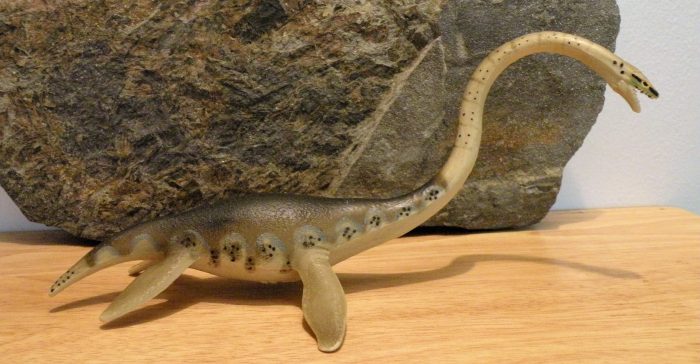
The 1991 Carnegie Collection Elasmosaurus may very well be the first mass produced toy depicting the marine reptile. I had one growing up and it was one of the best bathtub toys I owned! It was released alongside a Mosasaurus obviously inspired by old paleoart by the likes of Zdeněk Burian. The Mosasaurus hasn’t aged well, but what about this Elasmosaurus?
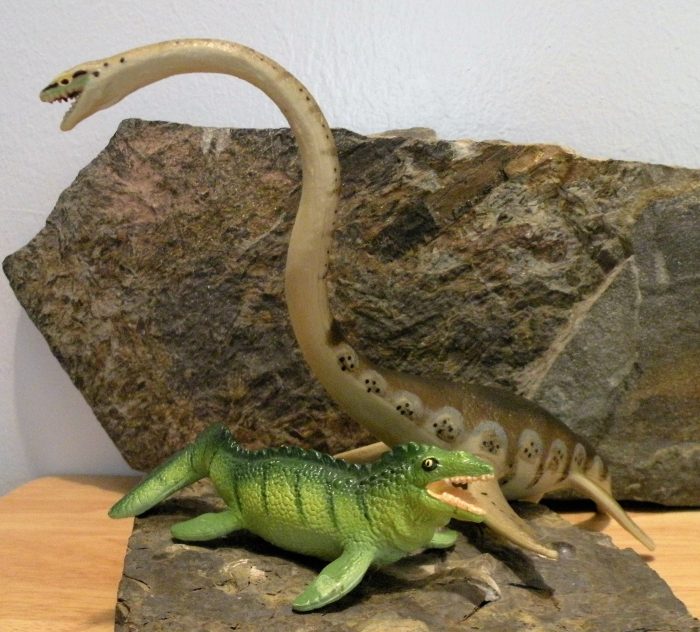
For the most part this model has held up well. It has that standard plesiosaur body plan that is difficult to mess up too much. But much like that old Mosasaurus this toy does suffer from its age. The neck is bent upwards and curved as if attempting to snatch some poor Pteranodon from the air. We of course now know that plesiosaurs had stiff necks held out in front of them and despite what so many alleged Nessie pictures suggest these animals did not swim around with their necks out of the water like a swan.
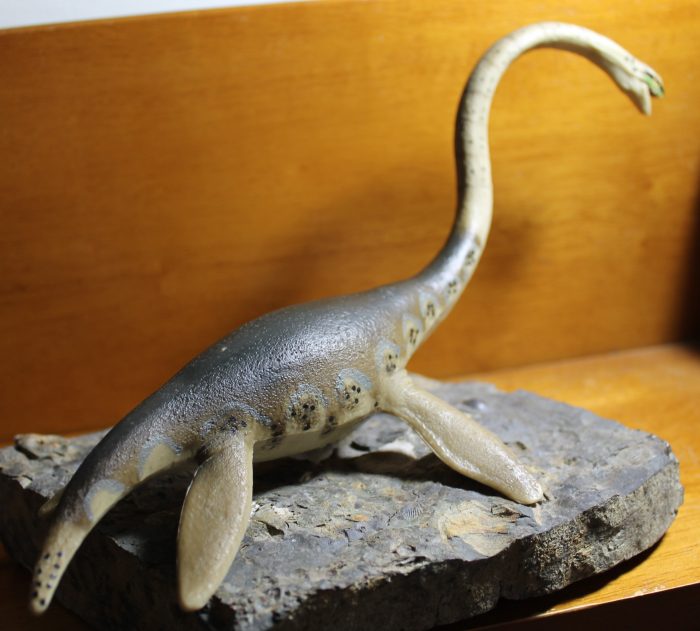
The head is also concerning because it completely ignores the somewhat odd cranial anatomy of this animal. To get an idea of what it should look like it would be good to compare it with the 2013 Wild Safari model. The skull should be low with the eyes towards the top of the head, not the sides. Also the teeth should be jutting out forward from the mouth, no doubt a useful tool for snaring fishes. What we have on the Carnegie model is just a generic looking lizard head. It’s a pity because the model is otherwise decent, just got to cut that head off.
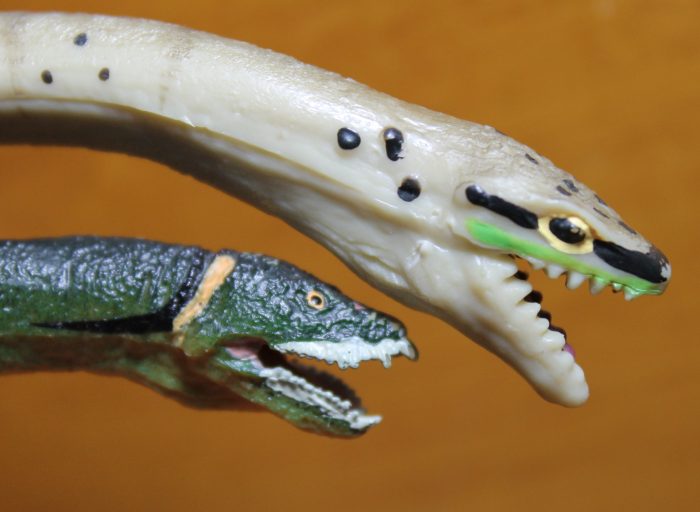
Despite its shortcomings anatomically the Carnegie Elasmosaurus has stood the test of time in other ways. Up until the complete retirement of the Carnegie Collection this toy could be found regularly and a few variations exist. There is this model that I own, painted in various shades of brown with a dark brown back and intricate gray colored, half-moon designs running down the side along with dark brown splotches overlaid with small black spots. The dark brown coloration stops 1/3 of the way up the neck but faint bands and dark spots run up the rest of its length. The head has black spotting and a black stripe that runs through the eyes and around the snout. A green stripe runs below each eye. Mine is odd in that it has spots on only one of the fore-flippers, and not on the rest. I’m not sure if that’s consistent with other models or unique to my own.
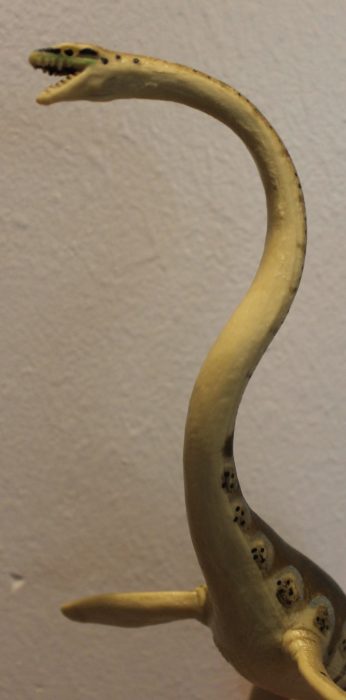
Another version exists that is very similar to my own, the only difference being that there are darker, thicker bands running up the neck, brown edging on the front flippers, and no green stripe below the eyes. In 2007 the model would be released yet again with a completely new paint scheme. That one was blue with darker blue blotches along the back, a believable color scheme for an aquatic animal that would no doubt serve as camouflage in the rippling blue water. But the older color schemes work too.
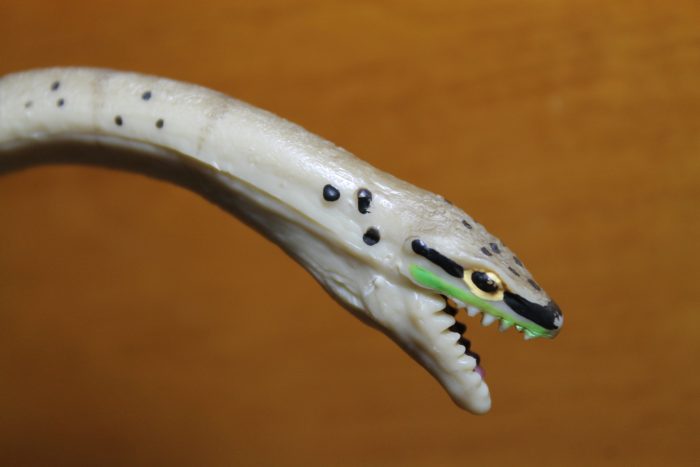
The toy is an impressive size; it measures 11” from tail to head, not counting the curvature in the neck. The details on the toy are slim but that’s to be expected from what is supposed to be a streamlined aquatic animal. There are some wrinkles where the fore-flippers meet the body and the model has a slightly dimpled texture. Three raised black bumps are sculpted on the neck just behind the head.
The Carnegie Elasmosaurus is a classic model of the genus and a must have for marine reptile buffs. It has some anatomical errors but is otherwise a well-made toy. Its large size and craning neck make it stand out on a shelf and it displays well. This model had a long run with the Carnegie Collection and is still easy to find and probably will be for years to come.
Disclaimer: links to Ebay and Amazon on the DinoToyBlog are affiliate links, so we make a small commission if you use them. Thanks for supporting us!




[…] sculpting on the head is more accurate than the Carnegie version but it is not perfect. The eyes look like they are placed close to the top of the head […]
Great review. I also have this one, picked up on eBay, plus the Safari one and the old Schleich (eBay again). The latter is even less accurate but it is big and has character. Looking forward to the Collecta Thalassomedon – seems to tick some boxes in terms of accuracy, especially with the head.
This has always been my favorite carnegie toy! Great review!
I remember always going on this blog before I was a meme er and always wondering why it had never gotten a review.
Thanks! It actually already is on the blog. But there are only a couple pictures and the statement that a review will be posted on a later date, that was posted in 2009. I had always assumed it had a review until I actually clicked on the link and only saw pictures. If I had known sooner I would have reviewed it sooner.